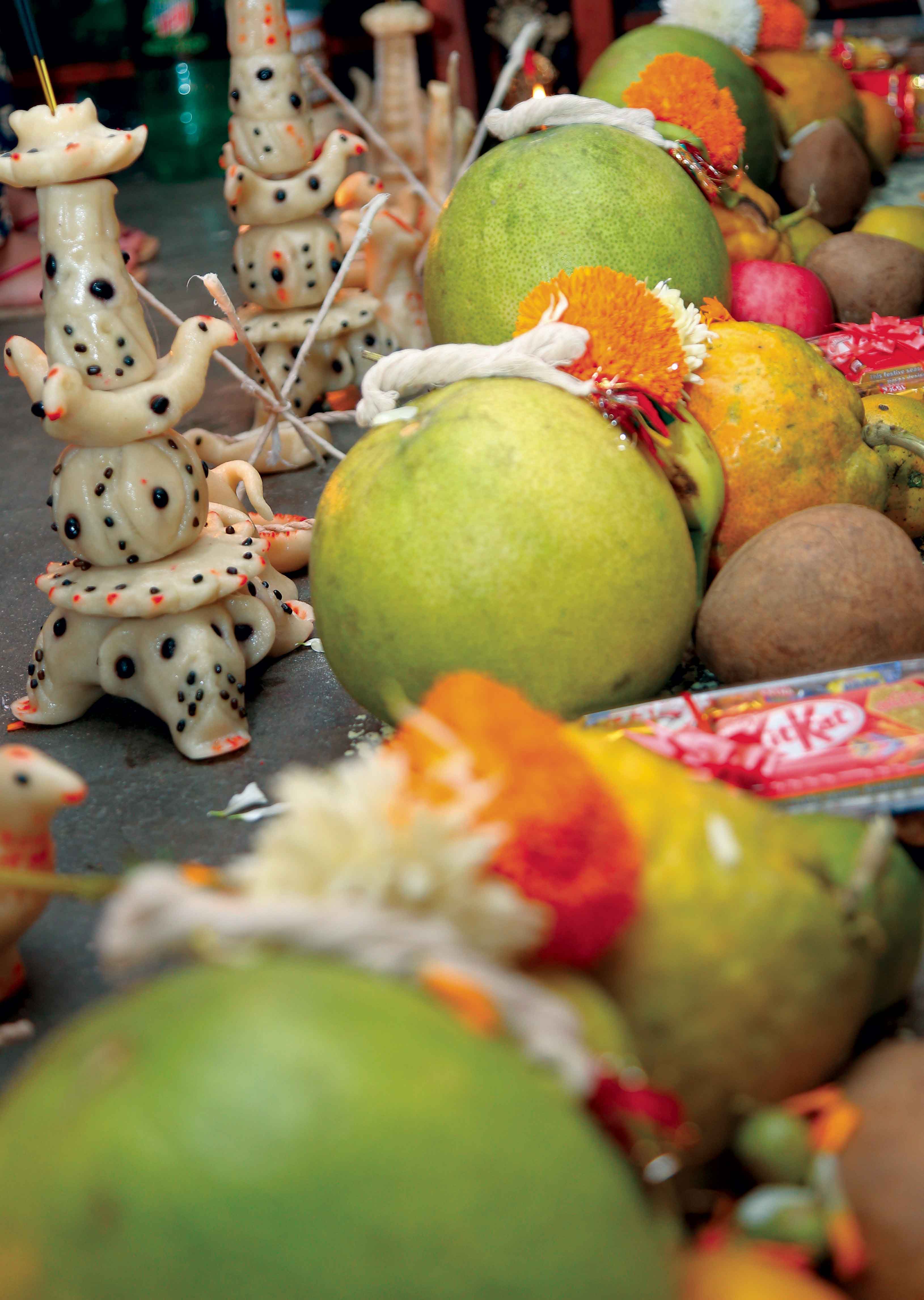Each year, two groups of people gather at Pulchowk in Lalitpur, days prior to the Rato Machinndranath Jatra, to prepare the chariot for the festival. Despite their busy lives, they still manage to get involved in the affair. Why they do it is certainly worth knowing.
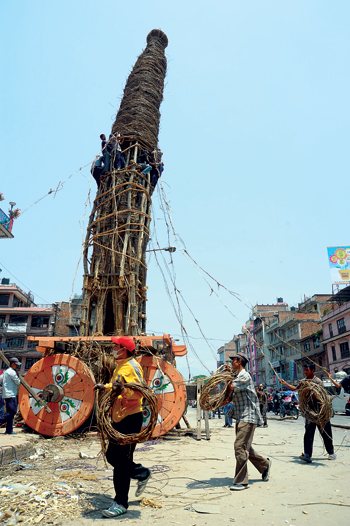 For about 12 days every year, around April-May, the street in Pulchowk near the fire brigade becomes the working ground for the making of the rath (chariot) of the Rain God, Rato Matsyendranath. This is where two world clash – the modern with its tangled wires and the ancient with strong, twisted ropes. The street is always busy with microbuses and motorbikes and people passing by. But not bothered much by this, a group of men are busy at constructing the chariot. These men, young and old, aren’t disturbed by the noise of the traffic or by the stares of the passerby, or even if they are, they don’t let that get in their way. They continue to work like they do, every year, taking turns to climb the unfinished structure, to put things together, to embellish the rath and, to rest. They wait for a while, every now and then, to gaze at the masterpiece they are creating. This rath that will contain the Rain God will soon be the center of attraction for everyone when the jatra starts.
For about 12 days every year, around April-May, the street in Pulchowk near the fire brigade becomes the working ground for the making of the rath (chariot) of the Rain God, Rato Matsyendranath. This is where two world clash – the modern with its tangled wires and the ancient with strong, twisted ropes. The street is always busy with microbuses and motorbikes and people passing by. But not bothered much by this, a group of men are busy at constructing the chariot. These men, young and old, aren’t disturbed by the noise of the traffic or by the stares of the passerby, or even if they are, they don’t let that get in their way. They continue to work like they do, every year, taking turns to climb the unfinished structure, to put things together, to embellish the rath and, to rest. They wait for a while, every now and then, to gaze at the masterpiece they are creating. This rath that will contain the Rain God will soon be the center of attraction for everyone when the jatra starts.
The Rato Matsyendranath Jatra is one of the oldest and longest festivals in the Kathmandu Valley. Each year, Barahi and Yanwal groups from various tole of Patan come together for more than a week prior to the jatra to prepare the rath of Rato Matsyendranath, the God of Rain. Although the jatra has always belonged to the community and people of Nepal, it has gained global attention recently. The picture taken by Navesh Chitrakar published by Reuters last year is the proof of it. Despite the jatra’s newfound international fame, finding people to work on the chariot has proven to be difficult. Earlier, people who made the rath worked inside their own communities. But today, most are employed in private and public organizations around the valley and beyond.
“It is hard for people with jobs to manage time,” shares Lusan Dongol, who has been involved in the making of the rath for more than nine years. He belongs to the Yanwal group, the body responsible for the ropes during the chariot-making process. According to Dongol, the guthi sanstha (social organization) provides wages amounting to Rs. 800 per day, which is not enough for regular jobholders with families to support but more than enough for youngsters freshly out of school. “The other reason for their involvement is the easy access to climbing the rath during the festival,” he adds.
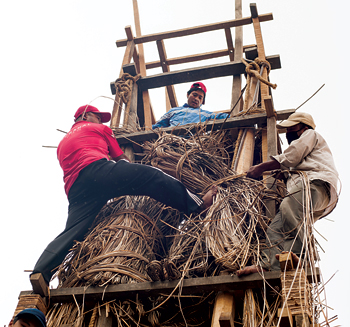 On the other hand, Kedar Barahi, who is responsible for the woodwork as part of the Barahi group, believes that most of the youngsters are involved because they desire to continue their ancestor’s work, as well as to catch up with friends. According to him, only old and retired individuals are involved in the guthi, but the tradition of including sons, who’ve already been through the pasni (rice-feeding ceremony), is still prevalent. Although it is not mandatory, this exposure helps them prepare for the future. The children then grow up to be directly involved in the process as gwahlis (helpers) before joining the guthi. Their daily wage is determined by the price of dhan (paddy) of that year. Traditionally, workers used to receive paddy as payment but now they are given money equivalent to one pathi of paddy per day, which amounts to Rs. 180.
On the other hand, Kedar Barahi, who is responsible for the woodwork as part of the Barahi group, believes that most of the youngsters are involved because they desire to continue their ancestor’s work, as well as to catch up with friends. According to him, only old and retired individuals are involved in the guthi, but the tradition of including sons, who’ve already been through the pasni (rice-feeding ceremony), is still prevalent. Although it is not mandatory, this exposure helps them prepare for the future. The children then grow up to be directly involved in the process as gwahlis (helpers) before joining the guthi. Their daily wage is determined by the price of dhan (paddy) of that year. Traditionally, workers used to receive paddy as payment but now they are given money equivalent to one pathi of paddy per day, which amounts to Rs. 180.
The rath making process starts from six in the morning and ends at around seven in the evening. The Barahi and Yanwal take turns working on the khat (palanquin). The gwahlis of the Barahi group are part of the process for only two to three days; hence, it is easier for them to take a break from their regular jobs. “We are involved on the first day, then during the joining of the wheels and finally while putting out the rath. Those particular days are fixed in advance as they are done according to the lunar calendar,” explains Kedar. While those involved in the guthi are regularly involved in the process, the gwahlis have to be present only when hard work is required. On the contrary, when it comes to the Yanwal group, most of the tasks are done by gwahlis as there are more risks involved. “Those associated with the guthi are there to supervise and help us share techniques in case we get stuck,” says Dongol. The Yanwal are planning to utilize technology in order to decrease human effort during the process (they have already begun using pulleys since last year), while the Barahi haven’t made much use of modern technology.
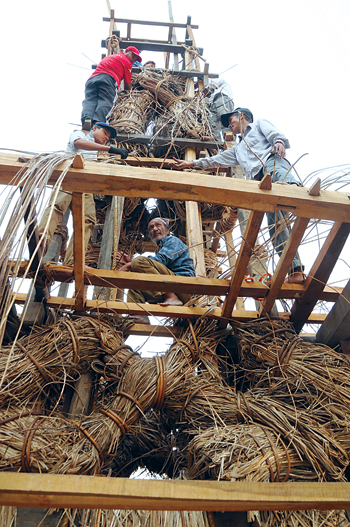 Since the chariot-making task proceeds according to the lunar calendar, the involved parties are already informed beforehand. Still, the nayas (leaders) of both the groups inform the members about the exact dates. They then gather according to the chosen time and start working. To make things easier for them, the necessary materials are already collected by the guthi sansthan at the Matsyendrabahal Temple in Tangal, Patan.
Since the chariot-making task proceeds according to the lunar calendar, the involved parties are already informed beforehand. Still, the nayas (leaders) of both the groups inform the members about the exact dates. They then gather according to the chosen time and start working. To make things easier for them, the necessary materials are already collected by the guthi sansthan at the Matsyendrabahal Temple in Tangal, Patan.
Festivals like Rato Matsyendranath Jatra helps us to relive our childhood days whether we participate in the jatra directly or just as an observer. At the same time, it is necessary for people, young and old, be involved despite their busy schedule to keep our culture alive. And this is what the ones involved in making rath have been doing – giving what they can because they care.
Rato Matsyendranath Jatra
Rato Matsyendranath Jatra has been one of the oldest and longest jatras celebrated in Patan by Newar community. Also known as Bungdyo: Jatra, this festival is a chariot procession honoring the Buddhist deity of compassion who is also known as god of rain.
According to legend, once upon a time when Gorakhnath came to visit Kathmandu Valley, no one took notice of him. That angered him and hence he started meditating sitting on serpents of the valley that were responsible for the rain. This caused drought which was solved by bringing Rato Matsyendranath, Gorakhnath’s teacher to the country from Assam by King Narendradev, Tantrik Acharya Bandhudatta, and Farmer Lalit Rathchakra. Knowing that Rato Matsyendranath is in the country, Gorakhnath goes to meet him, thus freeing the serpents, resulting in rainfall.
Another legend says that when the king, the tantric and the farmer were resting in Bungamati for a while, the children took the pot that held Rato Matsyendranath. When the group asked to have the pot returned, the children put the condition that said they will return the pot only if the thing inside the pot would be shared into halves with them. Thus, Rato Matsyendranath is kept in Bungamati for six months while for the other six months, it is kept in Matsyendrabahal of Patan.
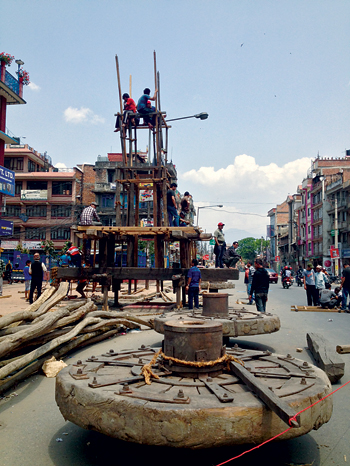 Other Jatras involving raths
Other Jatras involving raths
Janbadyo Jatra
Also known as Seto Matsyendranath Jatra, this festival, which takes place in Kathmandu, is shorter in comparison to its Patan counterpart. The three-day long jatra also involves the making of the rath.
Machinndranath Jatra in Charikot
The Matsyendranath Jatra in Charikot is similar to the festival in Patan. It also involves the construction of the chariot.
Bisket Jatra
The ten-day long Bisket Jatra of Bhaktapur features the pulling of the raths of Bhairab and Bhandrakali across various part of the ancient town. Unlike the chariots of Matsyendranath, the raths used here are not dismantled.
Indra Jatra
During Indra Jatra, the raths of the Kumari, Bhairab and Ganesh are pulled for three days. Like the Bisket Jatra raths, the chariots aren’t dismantled and remade.







